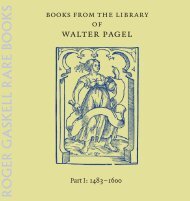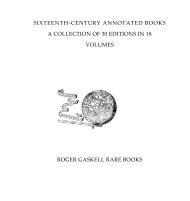pdf - Roger Gaskell Rare Books
pdf - Roger Gaskell Rare Books
pdf - Roger Gaskell Rare Books
Create successful ePaper yourself
Turn your PDF publications into a flip-book with our unique Google optimized e-Paper software.
Provenance: Old signature on printed titlepage scored through.<br />
First edition. Keynes 34; Wing H1091; ESTC R17816;<br />
Garrison–Morton 467; Norman Library 1011.<br />
Harvey’s second great contribution to physiology, this is one of<br />
the classics of embryology. The problem of generation was a much<br />
more diYcult one than the circulation of the blood. It occupied<br />
Harvey for most of his life and in the end it was not susceptible to a<br />
full solution in his time. The great contributions of this book were<br />
however of huge signiWcance. Harvey’s doctrine that every living<br />
thing comes from an egg; his insistence on epigenesis as opposed<br />
to preformation of the embryo; and his rejection of spontaneous<br />
generation are only three of the ten of Harvey’s achievements in this<br />
book identiWed by Needham (History of Embryology, pp. 149–50).<br />
In addition, the last part of the book is a treatise on gynaecology<br />
and obstetrics drawing on Harvey’s own practice which though<br />
celebrated in Herbert Spencer’s 1921 Harveian Oration, seems to<br />
have been little discussed since then.<br />
The famous and often reproduced engraved title, unsigned<br />
but attributed to Richard Gaywood (c. 1630–1680), shows the<br />
Wgure of Jove taking the top oV a large egg, out of which escape a<br />
Xurry of small creatures. On the egg is the legend Ex ovo omnia,<br />
everything from an egg, the central pillar of Harvey’s theory of<br />
generation. It was probably Gaywood who also etched a portrait<br />
of Harvey that was originally intended for the book but which<br />
was suppressed before publication. (On the etched titlepage and<br />
portrait see Keynes, Life of Harvey, pp. 332–334 and plates XXVIII<br />
and XXIX.)<br />
85<br />
HARVEY, William (1578–1657)<br />
Anatomical exercitations, concerning the generation of living<br />
creatures: to which are added particular discourses, of births,<br />
conceptions, &c.<br />
London: printed by James Young, for Octavian Pulleyn, and are to be sold<br />
at his shop at the sign of the Rose in St. Pauls Church-yard, 1653.<br />
8vo: A 8 (–A1, blank) a 8 8 B–2N 8 (–2N8, blank), 302 of 304 leaves, pp.<br />
[46] 551 562–566 [2] (errata on 2N7, verso blank).<br />
Engraved frontispiece showing a bust of Harvey, signed ‘W: F: fec’<br />
supplied from a later impression on heavy paper (probably<br />
Wellcome, Portraits 1312.9, described as an eighteenthcentury<br />
impression from the original plate).<br />
164 x 100mm. Titlepage soiled and frayed in the margins; piece torn<br />
from fore margin of C1 touching a few letters; one or two headlines<br />
shaved; waterstained; overall light browning and soiling.<br />
Binding: Contemporary panelled calf. Rebacked, headcap rubbed,<br />
corners worn.







